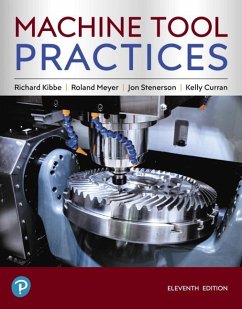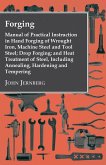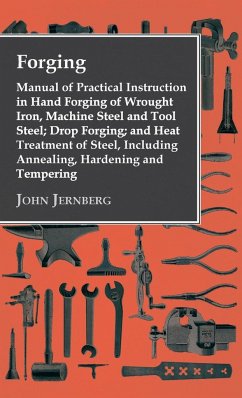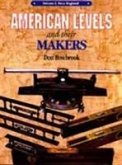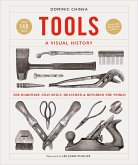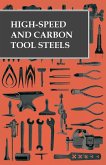- Gebundenes Buch
- Merkliste
- Auf die Merkliste
- Bewerten Bewerten
- Teilen
- Produkt teilen
- Produkterinnerung
- Produkterinnerung
For courses in machine shop, machine tool technology, machining processes/manufacturing processes technology, industrial technology, industrial mechanics, and industrial engineering at the undergraduate level. The all-in-one solution for teaching machining, BPR, GD&T, and CNC courses Machine Tool Practices provides clear, practical, and richly illustrated treatment of machine tool technology and prepares students for NIMS certification. Vast in breadth and depth, this is the definitive text for training computer numerical controllers, conventional machine operators, general machinists, and…mehr
Andere Kunden interessierten sich auch für
![Forging - Manual of Practical Instruction in Hand Forging of Wrought Iron, Machine Steel and Tool Steel; Drop Forging; and Heat Treatment of Steel, Including Annealing, Hardening and Tempering Forging - Manual of Practical Instruction in Hand Forging of Wrought Iron, Machine Steel and Tool Steel; Drop Forging; and Heat Treatment of Steel, Including Annealing, Hardening and Tempering]() John JernbergForging - Manual of Practical Instruction in Hand Forging of Wrought Iron, Machine Steel and Tool Steel; Drop Forging; and Heat Treatment of Steel, Including Annealing, Hardening and Tempering33,99 €
John JernbergForging - Manual of Practical Instruction in Hand Forging of Wrought Iron, Machine Steel and Tool Steel; Drop Forging; and Heat Treatment of Steel, Including Annealing, Hardening and Tempering33,99 €![Forging - Manual of Practical Instruction in Hand Forging of Wrought Iron, Machine Steel and Tool Steel; Drop Forging; and Heat Treatment of Steel, In Forging - Manual of Practical Instruction in Hand Forging of Wrought Iron, Machine Steel and Tool Steel; Drop Forging; and Heat Treatment of Steel, In]() John JernbergForging - Manual of Practical Instruction in Hand Forging of Wrought Iron, Machine Steel and Tool Steel; Drop Forging; and Heat Treatment of Steel, In36,99 €
John JernbergForging - Manual of Practical Instruction in Hand Forging of Wrought Iron, Machine Steel and Tool Steel; Drop Forging; and Heat Treatment of Steel, In36,99 €![American Levels and Their Makers: New England American Levels and Their Makers: New England]() Don RosebrookAmerican Levels and Their Makers: New England53,99 €
Don RosebrookAmerican Levels and Their Makers: New England53,99 €![Tools a Visual History Tools a Visual History]() Dominic ChineaTools a Visual History26,99 €
Dominic ChineaTools a Visual History26,99 €![Floret Farm's A Year in Flowers Floret Farm's A Year in Flowers]() Erin BenzakeinFloret Farm's A Year in Flowers23,64 €
Erin BenzakeinFloret Farm's A Year in Flowers23,64 €![Cool Tools: A Catalog of Possibilities Cool Tools: A Catalog of Possibilities]() Cool Tools: A Catalog of Possibilities34,99 €
Cool Tools: A Catalog of Possibilities34,99 €![High-Speed and Carbon Tool Steels High-Speed and Carbon Tool Steels]() AnonHigh-Speed and Carbon Tool Steels14,99 €
AnonHigh-Speed and Carbon Tool Steels14,99 €-
-
-
For courses in machine shop, machine tool technology, machining processes/manufacturing processes technology, industrial technology, industrial mechanics, and industrial engineering at the undergraduate level. The all-in-one solution for teaching machining, BPR, GD&T, and CNC courses Machine Tool Practices provides clear, practical, and richly illustrated treatment of machine tool technology and prepares students for NIMS certification. Vast in breadth and depth, this is the definitive text for training computer numerical controllers, conventional machine operators, general machinists, and tool and tie makers. The 11th edition includes dramatically expanded content and supplements on blueprint reading, GD&T, and CNC, giving it the potential to be the sole source of material for courses on these topics, while saving students the expense of two extra texts.
Hinweis: Dieser Artikel kann nur an eine deutsche Lieferadresse ausgeliefert werden.
Hinweis: Dieser Artikel kann nur an eine deutsche Lieferadresse ausgeliefert werden.
Produktdetails
- Produktdetails
- Verlag: Pearson Education
- 11th edition
- Seitenzahl: 800
- Erscheinungstermin: 1. April 2019
- Englisch
- Abmessung: 284mm x 225mm x 36mm
- Gewicht: 1908g
- ISBN-13: 9780134893501
- ISBN-10: 0134893506
- Artikelnr.: 57010145
- Herstellerkennzeichnung
- Libri GmbH
- Europaallee 1
- 36244 Bad Hersfeld
- gpsr@libri.de
- Verlag: Pearson Education
- 11th edition
- Seitenzahl: 800
- Erscheinungstermin: 1. April 2019
- Englisch
- Abmessung: 284mm x 225mm x 36mm
- Gewicht: 1908g
- ISBN-13: 9780134893501
- ISBN-10: 0134893506
- Artikelnr.: 57010145
- Herstellerkennzeichnung
- Libri GmbH
- Europaallee 1
- 36244 Bad Hersfeld
- gpsr@libri.de
About our authors Jon Stenerson served an apprenticeship in toolmaking with Mercury Marine and was an instructor in the Machine Tool Program at Fox Valley Technical College (FVTC) in Appleton, WI. An industry consultant, Jon is the author of textbooks in the fields of machining, CNC programming and industrial automation. He has a BBA from the University of Wisconsin Oshkosh and a master's degree in vocational education from the University of Wisconsin-Stout. Kelly S. Curran grew up in Michigan's Upper Peninsula, where he started working in machine shops at a young age. Mr. Curran has considerable machine shop experience as well as industrial teaching experience. He is the author and coauthor of several publications in the machine tool manufacturing field. Mr. Curran has spent many years developing a self-paced machine tool curriculum for the State of Wisconsin and Fox Valley Technical College. He holds a bachelor's degree in career, technical education and training from the University of Wisconsin-Stout, an associate of applied science degree with an emphasis in machine tool from Ferris State College, and an associate of applied science degree with an emphasis in business from Northern Michigan University.
SECTION A
1. Careers and the Machinist's Role in Process Plans
2. Manufacturing Competitiveness and Improvement
3. Shop Safety
4. Threads and Fasteners
5. Blueprint Reading Fundamentals
6. Views and Line Types
7. Dimensions, Tolerances, and Fits
8. Fundamentals of GD&T
9. Geometric Tolerancing
SECTION B: HAND TOOLS
1. Arbor and Shop Presses
2. Work-Holding and Hand Tools
3. Hacksaws
4. Files
5. Hand Reamers
6. Identification and Uses of Taps
7. Tapping Procedures
8. Thread-Cutting Dies and Their Uses
9. Off-Hand Grinding
SECTION C: DIMENSIONAL MEASUREMENT
1. Measurement and Common Measuring Tools
2. Systems of Measurement
3. Using Steel Rules
4. Using Vernier, Dial, and Digital Instruments for Direct Measurements
5. Using Micrometers
6. Using Comparison Measuring Instruments
7. Using Gage Blocks
8. Using Angular Measuring Instruments
9. Quality in Manufacturing
10. Statistics in Manufacturing
SECTION D: MATERIALS
1. Selection and Identification of Steels
2. Selection and Identification of Nonferrous Metals
3. Hardening, Case Hardening, and Tempering
4. Annealing, Normalizing, and Stress Relieving
5. Rockwell and Brinell Hardness Testers
SECTION E: LAYOUT
1. Layout Tools
2. Basic Semiprecision Layout Practice
3. Basic Precision Layout Practice
SECTION F: PREPARATION FOR MACHINING OPERATIONS
1. Machinability and Chip Formation
2. Speeds and Feeds for Machine Tools
3. Cutting Fluids
4. Carbide Tooling Specification and Selection
SECTION G: SAWING MACHINES
1. Types of Cutoff Machines and Safety
2. Using Horizontal Cutoff Saws
3. Preparing a Vertical Band Machine for Use
4. Using a Vertical Band Saw
SECTION H: DRILLING MACHINES
1. Drill Press Fundamentals
2. Drilling Tools
3. Hand Grinding of Drills on the Pedestal Grinder
4. Operating Drilling Machines
5. Countersinking and Counterboring
6. Reaming in the Drill Press
SECTION I: TURNING MACHINES
1. Engine Lathe Fundamentals
2. Toolholders and Toolholding
3. Cutting Tools for the Lathe
4. Lathe Spindle Tooling
5. Operating Lathe Controls
6. Facing and Center Drilling
7. Turning between Centers
8. Alignment of Lathe Centers
9. Other Lathe Operations
10. Sixty-Degree Thread Information and Calculations
11. Cutting Unified External Threads
12. Cutting Unified Internal Threads
13. Cutting Tapers
14. Using Steady and Follower Rests
15. Additional Thread Forms
16. Cutting Acme Threads on the Lathe
SECTION J: VERTICAL MILLING MACHINES
1. Vertical Milling Machines
2. Cutting Tools and Cutting Tool Holders for the Vertical Milling Machine
3. Setups on the Vertical Milling Machine
4. Vertical Milling Machine Operations
5. Using an Offset Boring Head
SECTION K: HORIZONTAL SPINDLE MILLING MACHINES
1. Horizontal Spindle Milling Machines
2. Types of Spindles, Arbors, and Adapters
3. Arbor-Driven Milling Cutters
4. Work-Holding Methods and Standard Setups
5. Machine Setup and Plain Milling
6. Using Side Milling Cutters
SECTION L: GRINDING AND ABRASIVE MACHINING PROCESSES
1. Types of Grinders
2. Selection and Use of Grinding Wheels
3. Setup of Surface Grinders
4. Using a Surface Grinder
5. Cylindrical Grinding
6. Using a Cylindrical Grinder
7. Universal Tool and Cutter Grinder
SECTION M: COMPUTER NUMERICAL CONTROL AND OTHER ADVANCED MACHINING
PROCESSES
1. Fundamentals of Computer Numerical Control (CNC)
2. Fundamentals of Machining Centers
3. Fundamentals of Programming Machining Centers
4. Programming Examples
5. Programming Canned Cycles for Machining Centers
6. CNC Turning Machines
7. Programming CNC Turning Centers
8. Programming Canned Cycles for CNC Turning Centers
9. Advanced Machining Processes
1. Careers and the Machinist's Role in Process Plans
2. Manufacturing Competitiveness and Improvement
3. Shop Safety
4. Threads and Fasteners
5. Blueprint Reading Fundamentals
6. Views and Line Types
7. Dimensions, Tolerances, and Fits
8. Fundamentals of GD&T
9. Geometric Tolerancing
SECTION B: HAND TOOLS
1. Arbor and Shop Presses
2. Work-Holding and Hand Tools
3. Hacksaws
4. Files
5. Hand Reamers
6. Identification and Uses of Taps
7. Tapping Procedures
8. Thread-Cutting Dies and Their Uses
9. Off-Hand Grinding
SECTION C: DIMENSIONAL MEASUREMENT
1. Measurement and Common Measuring Tools
2. Systems of Measurement
3. Using Steel Rules
4. Using Vernier, Dial, and Digital Instruments for Direct Measurements
5. Using Micrometers
6. Using Comparison Measuring Instruments
7. Using Gage Blocks
8. Using Angular Measuring Instruments
9. Quality in Manufacturing
10. Statistics in Manufacturing
SECTION D: MATERIALS
1. Selection and Identification of Steels
2. Selection and Identification of Nonferrous Metals
3. Hardening, Case Hardening, and Tempering
4. Annealing, Normalizing, and Stress Relieving
5. Rockwell and Brinell Hardness Testers
SECTION E: LAYOUT
1. Layout Tools
2. Basic Semiprecision Layout Practice
3. Basic Precision Layout Practice
SECTION F: PREPARATION FOR MACHINING OPERATIONS
1. Machinability and Chip Formation
2. Speeds and Feeds for Machine Tools
3. Cutting Fluids
4. Carbide Tooling Specification and Selection
SECTION G: SAWING MACHINES
1. Types of Cutoff Machines and Safety
2. Using Horizontal Cutoff Saws
3. Preparing a Vertical Band Machine for Use
4. Using a Vertical Band Saw
SECTION H: DRILLING MACHINES
1. Drill Press Fundamentals
2. Drilling Tools
3. Hand Grinding of Drills on the Pedestal Grinder
4. Operating Drilling Machines
5. Countersinking and Counterboring
6. Reaming in the Drill Press
SECTION I: TURNING MACHINES
1. Engine Lathe Fundamentals
2. Toolholders and Toolholding
3. Cutting Tools for the Lathe
4. Lathe Spindle Tooling
5. Operating Lathe Controls
6. Facing and Center Drilling
7. Turning between Centers
8. Alignment of Lathe Centers
9. Other Lathe Operations
10. Sixty-Degree Thread Information and Calculations
11. Cutting Unified External Threads
12. Cutting Unified Internal Threads
13. Cutting Tapers
14. Using Steady and Follower Rests
15. Additional Thread Forms
16. Cutting Acme Threads on the Lathe
SECTION J: VERTICAL MILLING MACHINES
1. Vertical Milling Machines
2. Cutting Tools and Cutting Tool Holders for the Vertical Milling Machine
3. Setups on the Vertical Milling Machine
4. Vertical Milling Machine Operations
5. Using an Offset Boring Head
SECTION K: HORIZONTAL SPINDLE MILLING MACHINES
1. Horizontal Spindle Milling Machines
2. Types of Spindles, Arbors, and Adapters
3. Arbor-Driven Milling Cutters
4. Work-Holding Methods and Standard Setups
5. Machine Setup and Plain Milling
6. Using Side Milling Cutters
SECTION L: GRINDING AND ABRASIVE MACHINING PROCESSES
1. Types of Grinders
2. Selection and Use of Grinding Wheels
3. Setup of Surface Grinders
4. Using a Surface Grinder
5. Cylindrical Grinding
6. Using a Cylindrical Grinder
7. Universal Tool and Cutter Grinder
SECTION M: COMPUTER NUMERICAL CONTROL AND OTHER ADVANCED MACHINING
PROCESSES
1. Fundamentals of Computer Numerical Control (CNC)
2. Fundamentals of Machining Centers
3. Fundamentals of Programming Machining Centers
4. Programming Examples
5. Programming Canned Cycles for Machining Centers
6. CNC Turning Machines
7. Programming CNC Turning Centers
8. Programming Canned Cycles for CNC Turning Centers
9. Advanced Machining Processes
SECTION A
1. Careers and the Machinist's Role in Process Plans
2. Manufacturing Competitiveness and Improvement
3. Shop Safety
4. Threads and Fasteners
5. Blueprint Reading Fundamentals
6. Views and Line Types
7. Dimensions, Tolerances, and Fits
8. Fundamentals of GD&T
9. Geometric Tolerancing
SECTION B: HAND TOOLS
1. Arbor and Shop Presses
2. Work-Holding and Hand Tools
3. Hacksaws
4. Files
5. Hand Reamers
6. Identification and Uses of Taps
7. Tapping Procedures
8. Thread-Cutting Dies and Their Uses
9. Off-Hand Grinding
SECTION C: DIMENSIONAL MEASUREMENT
1. Measurement and Common Measuring Tools
2. Systems of Measurement
3. Using Steel Rules
4. Using Vernier, Dial, and Digital Instruments for Direct Measurements
5. Using Micrometers
6. Using Comparison Measuring Instruments
7. Using Gage Blocks
8. Using Angular Measuring Instruments
9. Quality in Manufacturing
10. Statistics in Manufacturing
SECTION D: MATERIALS
1. Selection and Identification of Steels
2. Selection and Identification of Nonferrous Metals
3. Hardening, Case Hardening, and Tempering
4. Annealing, Normalizing, and Stress Relieving
5. Rockwell and Brinell Hardness Testers
SECTION E: LAYOUT
1. Layout Tools
2. Basic Semiprecision Layout Practice
3. Basic Precision Layout Practice
SECTION F: PREPARATION FOR MACHINING OPERATIONS
1. Machinability and Chip Formation
2. Speeds and Feeds for Machine Tools
3. Cutting Fluids
4. Carbide Tooling Specification and Selection
SECTION G: SAWING MACHINES
1. Types of Cutoff Machines and Safety
2. Using Horizontal Cutoff Saws
3. Preparing a Vertical Band Machine for Use
4. Using a Vertical Band Saw
SECTION H: DRILLING MACHINES
1. Drill Press Fundamentals
2. Drilling Tools
3. Hand Grinding of Drills on the Pedestal Grinder
4. Operating Drilling Machines
5. Countersinking and Counterboring
6. Reaming in the Drill Press
SECTION I: TURNING MACHINES
1. Engine Lathe Fundamentals
2. Toolholders and Toolholding
3. Cutting Tools for the Lathe
4. Lathe Spindle Tooling
5. Operating Lathe Controls
6. Facing and Center Drilling
7. Turning between Centers
8. Alignment of Lathe Centers
9. Other Lathe Operations
10. Sixty-Degree Thread Information and Calculations
11. Cutting Unified External Threads
12. Cutting Unified Internal Threads
13. Cutting Tapers
14. Using Steady and Follower Rests
15. Additional Thread Forms
16. Cutting Acme Threads on the Lathe
SECTION J: VERTICAL MILLING MACHINES
1. Vertical Milling Machines
2. Cutting Tools and Cutting Tool Holders for the Vertical Milling Machine
3. Setups on the Vertical Milling Machine
4. Vertical Milling Machine Operations
5. Using an Offset Boring Head
SECTION K: HORIZONTAL SPINDLE MILLING MACHINES
1. Horizontal Spindle Milling Machines
2. Types of Spindles, Arbors, and Adapters
3. Arbor-Driven Milling Cutters
4. Work-Holding Methods and Standard Setups
5. Machine Setup and Plain Milling
6. Using Side Milling Cutters
SECTION L: GRINDING AND ABRASIVE MACHINING PROCESSES
1. Types of Grinders
2. Selection and Use of Grinding Wheels
3. Setup of Surface Grinders
4. Using a Surface Grinder
5. Cylindrical Grinding
6. Using a Cylindrical Grinder
7. Universal Tool and Cutter Grinder
SECTION M: COMPUTER NUMERICAL CONTROL AND OTHER ADVANCED MACHINING
PROCESSES
1. Fundamentals of Computer Numerical Control (CNC)
2. Fundamentals of Machining Centers
3. Fundamentals of Programming Machining Centers
4. Programming Examples
5. Programming Canned Cycles for Machining Centers
6. CNC Turning Machines
7. Programming CNC Turning Centers
8. Programming Canned Cycles for CNC Turning Centers
9. Advanced Machining Processes
1. Careers and the Machinist's Role in Process Plans
2. Manufacturing Competitiveness and Improvement
3. Shop Safety
4. Threads and Fasteners
5. Blueprint Reading Fundamentals
6. Views and Line Types
7. Dimensions, Tolerances, and Fits
8. Fundamentals of GD&T
9. Geometric Tolerancing
SECTION B: HAND TOOLS
1. Arbor and Shop Presses
2. Work-Holding and Hand Tools
3. Hacksaws
4. Files
5. Hand Reamers
6. Identification and Uses of Taps
7. Tapping Procedures
8. Thread-Cutting Dies and Their Uses
9. Off-Hand Grinding
SECTION C: DIMENSIONAL MEASUREMENT
1. Measurement and Common Measuring Tools
2. Systems of Measurement
3. Using Steel Rules
4. Using Vernier, Dial, and Digital Instruments for Direct Measurements
5. Using Micrometers
6. Using Comparison Measuring Instruments
7. Using Gage Blocks
8. Using Angular Measuring Instruments
9. Quality in Manufacturing
10. Statistics in Manufacturing
SECTION D: MATERIALS
1. Selection and Identification of Steels
2. Selection and Identification of Nonferrous Metals
3. Hardening, Case Hardening, and Tempering
4. Annealing, Normalizing, and Stress Relieving
5. Rockwell and Brinell Hardness Testers
SECTION E: LAYOUT
1. Layout Tools
2. Basic Semiprecision Layout Practice
3. Basic Precision Layout Practice
SECTION F: PREPARATION FOR MACHINING OPERATIONS
1. Machinability and Chip Formation
2. Speeds and Feeds for Machine Tools
3. Cutting Fluids
4. Carbide Tooling Specification and Selection
SECTION G: SAWING MACHINES
1. Types of Cutoff Machines and Safety
2. Using Horizontal Cutoff Saws
3. Preparing a Vertical Band Machine for Use
4. Using a Vertical Band Saw
SECTION H: DRILLING MACHINES
1. Drill Press Fundamentals
2. Drilling Tools
3. Hand Grinding of Drills on the Pedestal Grinder
4. Operating Drilling Machines
5. Countersinking and Counterboring
6. Reaming in the Drill Press
SECTION I: TURNING MACHINES
1. Engine Lathe Fundamentals
2. Toolholders and Toolholding
3. Cutting Tools for the Lathe
4. Lathe Spindle Tooling
5. Operating Lathe Controls
6. Facing and Center Drilling
7. Turning between Centers
8. Alignment of Lathe Centers
9. Other Lathe Operations
10. Sixty-Degree Thread Information and Calculations
11. Cutting Unified External Threads
12. Cutting Unified Internal Threads
13. Cutting Tapers
14. Using Steady and Follower Rests
15. Additional Thread Forms
16. Cutting Acme Threads on the Lathe
SECTION J: VERTICAL MILLING MACHINES
1. Vertical Milling Machines
2. Cutting Tools and Cutting Tool Holders for the Vertical Milling Machine
3. Setups on the Vertical Milling Machine
4. Vertical Milling Machine Operations
5. Using an Offset Boring Head
SECTION K: HORIZONTAL SPINDLE MILLING MACHINES
1. Horizontal Spindle Milling Machines
2. Types of Spindles, Arbors, and Adapters
3. Arbor-Driven Milling Cutters
4. Work-Holding Methods and Standard Setups
5. Machine Setup and Plain Milling
6. Using Side Milling Cutters
SECTION L: GRINDING AND ABRASIVE MACHINING PROCESSES
1. Types of Grinders
2. Selection and Use of Grinding Wheels
3. Setup of Surface Grinders
4. Using a Surface Grinder
5. Cylindrical Grinding
6. Using a Cylindrical Grinder
7. Universal Tool and Cutter Grinder
SECTION M: COMPUTER NUMERICAL CONTROL AND OTHER ADVANCED MACHINING
PROCESSES
1. Fundamentals of Computer Numerical Control (CNC)
2. Fundamentals of Machining Centers
3. Fundamentals of Programming Machining Centers
4. Programming Examples
5. Programming Canned Cycles for Machining Centers
6. CNC Turning Machines
7. Programming CNC Turning Centers
8. Programming Canned Cycles for CNC Turning Centers
9. Advanced Machining Processes

